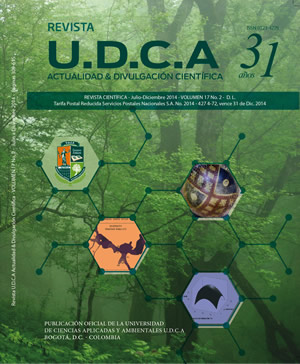Efecto de la humedad relativa sobre la germinación de las esporas de Beauveria bassiana y la patogenicidad a la broca del café Hypothenemus hampei
Effect of environmental moisture on the germination of Beauveria bassiana spores and their pathogenicity against the coffee berry borer
Contenido principal del artículo
Resumen
Este trabajo tuvo como objetivo evaluar la concentración, la pureza, la germinación y la patogenicidad sobre la broca del café de las esporas del hongo Beauveria bassiana en polvo, después de ser expuestas a los niveles de humedad de 99, 75, 65 y 39%, que se obtuvieron utilizando soluciones saturadas mantenidas en cámaras húmedas, a una temperatura constante de 24°C. Las evaluaciones del efecto de la humedad sobre las esporas, se realizaron luego de 1, 10 y 20 días de expuestas, a los niveles de humedad correspondientes. En los resultados, se obtuvo que la concentración, la pureza y la patogenicidad de las esporas, a través de los tiempos de exposición a los diferentes niveles de humedad, no presentaron marcada variación durante el tiempo de evaluación. La patogenicidad, se conservó con valores superiores a 86,7% en todos los niveles de humedad y tiempos de evaluación. La germinación fue la variable, que presentó la mayor variación y disminuyó, a través del tiempo: entre 88,9 a 82,1%, luego de un día, entre 79 y 68%, después de diez días y entre 62,2 a 56,2%, posterior a los 20 días. La germinación para los diferentes niveles de humedad solo presentó diferencias significativas dentro de los tiempos de evaluación de 1 y 10 días.
Palabras clave:
Descargas
Datos de publicación
Perfil evaluadores/as N/D
Declaraciones de autoría
- Sociedad académica
- Universidad de Ciencias Aplicadas UDCA
- Editorial
- Universidad de Ciencias Aplicadas y Ambientales U.D.C.A
Detalles del artículo
Referencias (VER)
ABBOTT, W.S. 1925. A method of computing the effectiveness of an insecticide. J. Econ. Entomol. 18:265-267.
ARRUBLA M., P.F.; CáRDENAS R., M.; POSADA F., F.J. 2008. Adherencia de las esporas de Beauveria bassiana formuladas en polvo y líquido sobre la broca del café. Rev. U.D.C.A Act. & Div. Cient. (Colombia). 11(1):123-131.
BATEMAN, R.P.; CAREY, M.; MOORE, D.; PRIOR, C. 1993. The enhanced infectivity of Metarhizium flavoviride in oil formulations to desert locusts at low humidities. Ann. Appl. Biol. 122:145-152.
BEXTINE, B.; THORVILSON, H.G. 2002. Field Applications of bait-formulated Beauveria bassiana alginate pellets for biological control of the red imported fire ant (Hymenoptera: Formicidae). Environ. Entomol. 31(4):746-752.
CáRDENAS M., R. 2000. Trampas y atrayentes para monitoreo de poblaciones de broca del café Hypothenemus hampei (Ferrari) (Col., Scolytidae). In: SIMPOSIO Latinoamericano de Caficultura, 19. San José (Costa Rica), Octubre 2-6, 2000. Memorias. San José (Costa Rica), ICAFE-PROMECAFE. p.369-379.
DOWD, P.F.; VEGA, F.E. 2003 Autodissemination of Beauveria bassiana by sap beetles (Coleoptera: Nitidulidae) to overwintering sites. Biocontrol Sci. Techn. 13(1):65-75.
DUFOUR, B.P. 2006. Elaboración de un método estándar para la evaluación del trampeo de la broca del café Hypothenemus hampei Ferr. Bol. Promecafé (Costa Rica). 109:5-9.
FERRON, P. 1978. Biological control of insect pests by entomogenous fungi. Ann. Rev. Entomol. 23:409-442.
FLóREZ M., E.; BUSTILLO P., A.E.; MONTOYA R., E.C. 1997. Evaluación de equipos de aspersión para el control de Hypothenemus hampei con el hongo Beauveria bassiana. Cenicafé (Colombia). 48(2):92-98.
GILBERT, J.; WOODS, S.M.; KROMER, U. 2008. Germination of ascospores of Gibberella zeae after exposure to various levels of relative humidity and temperature. Phytopathology. 98:504-508.
GUZMáN M., O.; BALDIóN R., J.V. 2003. El clima en la sede principal del Centro Nacional de Investigaciones de Café, Chinchiná, Caldas. Cenicafé (Colombia) 54(2):110-133.
HIDALGO, E.; MOORE, D.; LE PATOUREL, G. 1998. The effect of different formulation of Beauveria bassiana on Sitophilus zeamais in stored maize. J. Stored Prod. Res. 34(2-3):171-179.
HOSSAIN, M.S.; WILLIAMS, D.G.; HOSSAIN, M.A.B.M.; NORNG, S. 2007. Comparison of trap designs for use with aggregation pheromone and synthetic co-attractant in a user-friendly attract and kill system to control Carpophilus spp. (Coleoptera: Nitidulidae). Austral. J. Entomol. 46: 244-250.
INGLIS, G.D.; GOETTEL, M.S.; JOHNSON, D.L. 1993. Persistence of the entomopathogenic fungus, Beauveria bassiana, on phylloplanes of crested wheatgrass and alfalfa. Biol. Control. 3:258-270.
INGLIS, G.D.; JOHNSON, D.L.; GOETTEL, M.S. 1995. Influence of ultraviolet light protectans on persistence of the entomopathogenic fungus, Beauveria bassiana. Biol. Control. 5:581-590.
INGLIS, G.D.; JOHNSON, D.L.; GOETTEL, M.S. 1996. Effect of bait substrate and formulation on infection of grasshopper nymphs by Beauveria bassiana. Biocontrol Sci.Techn. 6:35-50.
KAPONGO, J.P.; SHIPP, L.; KEVAN, P.; BROADBENT, B. 2008. Optimal concentration of Beauveria bassiana vectored by bumble bees in relation to pest and bee mortality in greenhouse tomato and sweet pepper. Biol. Control. 53(5):797-812.
KLEIN, M.G.; LACEY, L.A. 1999. An attractant trap for autodissemination of entomopathogenic fungi into population of the Japanese beetles Popillia japonica (Coleoptera: Scarabaeidae). Biocontrol Sci. Techn. 9:151-158.
KOLLER, R.; JUNG, K.; SCHEU, S.; ZIMMERMANN, G.; RUTHER, J. 2005. Biocontrol of the forest cockchafer (Melolontha chafer hippocastani): Experiments on the applicability of the ?Catch and Infect?- Technique using a combination of attractant traps with the entomopathogenic fungus Beauveria brongniartii. IOBC/wprs Bull. 28(2):37-44.
LACAYO, L.; BARRIOS, M.; JIMéNEZ, C.; SANDINO, V. 1994. Uso de hongos entomopatógenos para el manejo de la broca del café (Hypothenemus hampei) en Nicaragua. Ministerio de Agricultura y Ganadería, Nicaragua, MAG Proyecto CATIE ? INTA / MIP. 5p.
LISANSKY, S.G.; COOMBS, J. 1994. Developments in the market for biopesticides. Brighton Crop Protection Conference - Pests and Diseases. 1:1049-1054.
MANIANIA, N.K. 2002. A low-cost contamination device for infecting adult Tsetse Flies, Glossina spp., with the entomopathogenic fungus Metarhizium anisopliae in the Field. Biocontrol Sci. Techn. 12:59- 66.
MARQUEZ, E.J.; ALVES, S.B. 1996. Optimization of formulations on the preservation of conidia of Beauveria bassiana (Bals.) Vuill. and Metharhizium anisoplae (Metschn.) Sorok. under different conditions of storage. Arquivos de Biologia e Tecnología. 39:861-877.
McCOY, C.W.; SAMSON, R.A.; BOUCIAS, D.G. 1988. Entomogenous fungi. p. 151-236. In: IGNOFFO, C.M. Ed. Handbook of Natural Pesticides, Vol. 5, Microbial Insecticides, Part A, Entomopathogenous Protozoa and Fungi. CRC Press, Boca Raton, Florida. 243p.
MOORE, D.; BRIDGE, P.D.; HIGGINS, P.M.; BATEMAN, R.P.; PRIOR, C. 1993. Ultra-violet radiation damage to Metharizium flavoviride conidia and the protection given by vegetable and mineral oils and chemical sunscreens. Ann. Appl. Biol. 122:605-616.
MOORE, D.; BATEMAN, R.P., CAREY, M.; PRIOR, C. 1995. Long-term storage of Metarhizium flavoviride conidia in oil formulations for the control of locusts and grasshoppers. Biocontrol Sci. Techn. 5:193-199.
NARVáEZ G., M. del P.; GONZáLEZ G., M.T.; BUSTILLO P., A.E.; CHAVES C., B.; MONTOYA R., E.C. 1997. Producción de esporas de los hongos Beauveria bassiana y Metarhizium anisopliae cultivados en arroz y sobre la broca del café. Rev. Col. Entomol. 23(2-3):125-131.
PéREZ, J.; INFANTE, F.; VEGA, F.E.; HOLGUíN, F.; MACíAS, J.; VALLE, J.; NIETO, G.; PETERSON, S.W.; KURTZMAN, C.P.; O?DONNELL, K. 2003. Mycobiota associated with the coffee berry borer (Hypothenemus hampei) in Mexico. Mycol. Res. 107:879-887.
PETERSON, A. 1959. Entomological techniques. How to work with insects. Ed. Edwards Brotheres. Michigan.435p.
POSADA F., F.J.; MARíN M., P.; PéREZ S., M. 1998. Paecilomyces lilacinus, enemigo natural de adultos de Hypothenemus hampei. Cenicafé (Colombia). 49(1):72-77.
POSADA F., F.J.; OSORIO, V.E.; VELáZQUEZ S., E.T. 2002. Evaluación de la patogenicidad de Beauveria bassiana sobre la broca del café empleando el método de aspersión foliar. Rev. Col. Entomol. 28(2):139-144.
POSADA, F.; VEGA, F. 2005. A new method to evaluate the biocontrol potential of single spore isolates of fungal entomopathogens. 10p. J. Insect Science. 5:37. Disponible desde Internet en: insectscience.org/5.37 (con acceso el 09/10/09).
SAS, INSTITUTE. 2003. SAS/Stat. User?s guide. SAS Institute Inc., Cary, NC. 1028p.
SHAFIR, S.; DAG, A.; BILU, A.; ABU-TOAMY, M.; ELAD, Y. 2006. Honey bee dispersal of the biocontrol agent Trichoderma harzianum T39: effectiveness in suppressing Botrytis cinerea on strawberry under field conditions. Europ. J. Plant Pathology. 116(2):119-128.
SMITH, S.M.; MOORE, D.; KARANJA, L.W.; CHANDI, E.A. 1999. Formulation of vegetable fat pellets with pheromone and Beauveria bassiana to control the larger grain borer, Prostephanus truncatus (Horn.). Pest. Sci. 55:711-718.
SPONAGEL, K.W. 1994. La broca del café Hypothenemus hampei en plantaciones de café robusta en la Amazonía Ecuatoriana. Wissenschaftlicher Fachverlag. Giessen. Alemania. 185p.
TINZAARA, W.; GOLD, C.S.; DICKE, M.; VAN HUIS, A.; NANKINGA, C.M.; KAGEZI, G.H.; RAGAMA, P. 2007. The use of aggregation pheromone to enhance dissemination of Beauveria bassiana for the control of the banana weevil in Uganda. Biocontrol Sci. Techn. 17(2):111-124.
UGINE, T.A.; WRAIGHT, S.P.; BROWNBRIDGE, M.; SANDERSON, J.P. 2005. Development of a novel bioassay for estimation of median lethal concentrations (LC50) and doses (LD50) of the entomopathogenic fungus Beauveria bassiana, against western flower thrips, Frankliniella occidentalis. J. Invertebr. Path. 89:210-218.
VEGA, F.E.; DOWD, P.F.; BARTELT, R.J. 1995. Dissemination of microbial agents using an autoinoculating device and several insect species as vectors. Biol. Contr. 5:545-552.
VéLEZ A., P.E. 1997. Evaluación de formulaciones en aceite y agua del hongo Beauveria bassiana (Balsamo) Vuillemin en campo. Rev. Col. Entomol. 23(1-2):137-142.
VéLEZ A., P.E.; MONTOYA R., E.C. 1993. Supervivencia del hongo Beauveria bassiana bajo radiación solar en condiciones de laboratorio y campo. Cenicafé (Colombia). 44(3):111-122.
VéLEZ A., P.E.; POSADA F., F.J.; MARíN, P.; BUSTILLO P., A.E.; GONZALES G., M.T.; OSORIO, E. 1997. Técnicas para el control de calidad de formulaciones de hongos entomopatógenos. Boletín Técnico, N? 17. Cenicafé (Colombia). 37p.
WALLER, J.M.; BIGGER, M.; HILLOCKS, R.J. 2007. Coffee pests, diseases and their management. Wallingford (Inglaterra), CAB. 434p.







